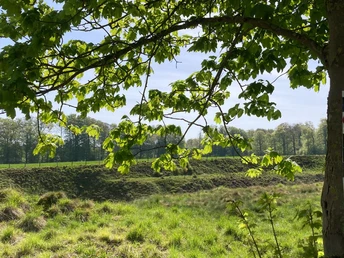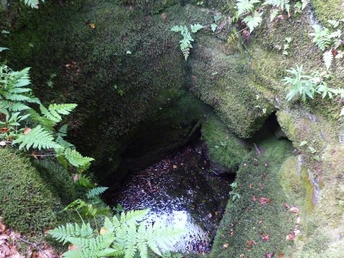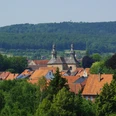- Photos & Map
How would you like to arrive?
- Description
- Good to know
- Nearby
Download GPX file
- 1:40 h
- 6.45 km
- 56 m
- 56 m
- 363 m
- 419 m
- 56 m
- Start: Info pavilion on the K69 in Blankenrode
- Destination: Info pavilion on the K69 in Blankenrode
The deserted town of Blankenrode
More than 750 years ago, Blankenrode was founded as a fortress to dominate the surrounding area and control the Warburger Weg. The 1.4 km long rampart, which was surrounded by a moat, consisted largely of earth and was fortified in some places with a sandstone wall. To the east of the complex was a castle, which was protected by its own rampart and a deep moat. However, the town was destroyed and abandoned after just 150 years. Today, only a few remnants remain of the former town, which lies buried under a blanket of green. Nevertheless, Blankenrode is considered one of the most exciting archaeological sites in North Rhine-Westphalia.
Bleikuhle
The Bleikuhle of Blankenrode is unique. The soil on the spoil heaps and in the Bleikuhle contains heavy metals and is toxic to common plants. However, the species of galmei plants have adapted to these soils containing heavy metals in such a way that they can only grow in these soils. Many of the plant species at the Bleikuhle - spring chickweed, galmei grass, galmei pursewort, Haller's goose cress, galmei dewcress and others - are rare and endangered because they only occur in a few places. Unique among the galmei plants in Europe, however, is the blue-violet galmei violet at the Bleikuhle of Blankenrode, which botanists refer to as "Viola guestphalica".
More than 750 years ago, Blankenrode was founded as a fortress to dominate the surrounding area and control the Warburger Weg. The 1.4 km long rampart, which was surrounded by a moat, consisted largely of earth and was fortified in some places with a sandstone wall. To the east of the complex was a castle, which was protected by its own rampart and a deep moat. However, the town was destroyed and abandoned after just 150 years. Today, only a few remnants remain of the former town, which lies buried under a blanket of green. Nevertheless, Blankenrode is considered one of the most exciting archaeological sites in North Rhine-Westphalia.
Bleikuhle
The Bleikuhle of Blankenrode is unique. The soil on the spoil heaps and in the Bleikuhle contains heavy metals and is toxic to common plants. However, the species of galmei plants have adapted to these soils containing heavy metals in such a way that they can only grow in these soils. Many of the plant species at the Bleikuhle - spring chickweed, galmei grass, galmei pursewort, Haller's goose cress, galmei dewcress and others - are rare and endangered because they only occur in a few places. Unique among the galmei plants in Europe, however, is the blue-violet galmei violet at the Bleikuhle of Blankenrode, which botanists refer to as "Viola guestphalica".
Good to know
Pavements
Unknown
Street
Gravel
Trail
Path
Best to visit
suitable
Depends on weather
Tour information
Familiy-Friendly
Loop Road
Equipment
Sturdy shoes are recommended.
Directions & Parking facilities
You can reach Blankenrode from the north via the K69 from Lichtenau, and via the K23 from Hardehausen
(road: Zur Altenauquelle)
You can also reach Blankenrode from the south via Meerhof.
There are plenty of parking spaces at the info pavilion.
In addition, there are further parking options at the Stadtwüstung and at the Bleikuhlen.
Additional information
Further information at: https://www.naturpark-teutoburgerwald.de/hoermuseum-stadtwuestung-blankenrode/
Author
Rubens Hey
Organization
Naturpark Teutoburger Wald / Eggegebirge
License (master data)
Author´s Tip / Recommendation of the author
A visit to the audio museum in the Blankenrode deserted town is definitely worthwhile.
Nearby






